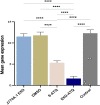Formulation and evaluation of atovaquone-loaded macrophage-derived exosomes against Toxoplasma gondii: in vitro and in vivo assessment
- PMID: 38014940
- PMCID: PMC10782982
- DOI: 10.1128/spectrum.03080-23
Formulation and evaluation of atovaquone-loaded macrophage-derived exosomes against Toxoplasma gondii: in vitro and in vivo assessment
Abstract
This study is the first of its kind that suggests exosomes as a nano-carrier loaded with atovaquone (ATQ), which could be considered as a new strategy for improving the effectiveness of ATQ against acute and chronic phases of Toxoplasma gondii.
Keywords: atovaquone; drug delivery; exosome; in vitro; in vivo; toxoplasmosis.
Conflict of interest statement
The authors declare no conflict of interest.
Figures










Similar articles
-
Histopathological and ultrastructural assessment of atovaquone-proguanil hydrochloride combination in chronic murine toxoplasmosis.Ultrastruct Pathol. 2021 Nov 2;45(6):376-383. doi: 10.1080/01913123.2021.1984349. Epub 2021 Oct 1. Ultrastruct Pathol. 2021. PMID: 34595988
-
An updated review of chemical compounds with anti-Toxoplasma gondii activity.Eur J Med Chem. 2023 Dec 15;262:115885. doi: 10.1016/j.ejmech.2023.115885. Epub 2023 Oct 16. Eur J Med Chem. 2023. PMID: 37871407 Review.
-
Toxoplasmosis in wallabies (Macropus rufogriseus and Macropus eugenii): blindness, treatment with atovaquone, and isolation of Toxoplasma gondii.J Parasitol. 2008 Aug;94(4):929-33. doi: 10.1645/GE-1448.1. J Parasitol. 2008. PMID: 18576797
-
Assessment of the activity of atovaquone-loaded nanocapsules in the treatment of acute and chronic murine toxoplasmosis.Parasite. 1998 Sep;5(3):223-9. doi: 10.1051/parasite/1998053223. Parasite. 1998. PMID: 9772721
-
Modeling the molecular basis of atovaquone resistance in parasites and pathogenic fungi.Trends Parasitol. 2007 Oct;23(10):494-501. doi: 10.1016/j.pt.2007.08.004. Epub 2007 Sep 7. Trends Parasitol. 2007. PMID: 17826334 Review.
References
-
- Tartarelli I, Tinari A, Possenti A, Cherchi S, Falchi M, Dubey JP, Spano F. 2020. During host cell traversal and cell-to-cell passage, Toxoplasma gondii sporozoites inhabit the parasitophorous vacuole and posteriorly release dense granule protein-associated membranous trails. Int J Parasitol 50:1099–1115. doi:10.1016/j.ijpara.2020.06.012 - DOI - PubMed
MeSH terms
Substances
LinkOut - more resources
Full Text Sources

